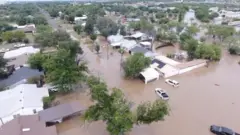Texas Floods: Examining Early Warnings Amidst Devastating Deluge
Texas Floods: Questions Arise Over Adequacy of Early Warning Systems
Central Texas is grappling with the devastating aftermath of unprecedented flash floods that have claimed the lives of nearly 80 individuals, with authorities cautioning that the death toll is likely to rise. The catastrophic event, which saw several months’ worth of rain fall in mere hours, has left communities shattered and raised critical questions about the effectiveness and timeliness of flood warnings issued by authorities.

The most tragic impact has been felt in Kerr County, where 28 children are among the reported fatalities. The county was particularly devastated when the Guadalupe River, within a staggering 45-minute period, surged by 26 feet, breaching its banks and inundating the surrounding areas. Many of the victims were at a girls’ camp, a stark reminder of the vulnerability of such facilities during extreme weather events.
Timeline of Warnings and Response
As rescue operations continue and the full scale of the disaster becomes clearer, scrutiny has fallen on the series of warnings issued in the lead-up to and during the floods. On Wednesday, the Texas Division of Emergency Management (TDEM) had already activated state emergency response resources in anticipation of significant flooding risks in West and Central Texas. Subsequently, on Thursday afternoon, the National Weather Service (NWS) issued a Flood Watch, specifically identifying Kerr County as an area highly susceptible to overnight flash flooding.
The critical phase began early Friday morning. At 01:14 local time, a flash flood warning was issued for Kerr County. This was followed by an emergency flash flood warning at 04:03, and another specific warning for the Guadalupe River at 05:34, underscoring the rapid escalation of the threat. Despite these warnings, the intensity and speed of the flooding appear to have surpassed initial expectations, leading to the severe loss of life.
Official Statements and Preparedness
Officials have been pressed on whether the existing warning systems were sufficient. Kerr County Judge Rob Kelly described the event as “unexpected,” stating there was “no reason to believe that this was gonna be any, anything like what’s happened here.” This sentiment highlights the extreme and potentially unprecedented nature of the rainfall and subsequent flooding.
The issue of preparedness in areas with limited cell phone coverage has also come to the fore. Nim Kidd, chief of the Texas Division of Emergency Management, acknowledged that in such areas, even with multiple alert systems, effective communication could be hampered. Dalton Rice, Kerrville City Manager, noted that public alert systems can sometimes lead to “desensitisation,” suggesting a need for more targeted or varied warning strategies.
The cost of implementing robust, county-administered warning systems, such as siren networks similar to those used for tornadoes, was cited as a reason for their absence in Kerr County, despite past considerations. The NWS defended its actions, stating that warnings were issued with “preliminary lead times of more than three hours” before warning criteria were met, and that forecast briefings had been provided to emergency management.
National Weather Service Staffing and Funding
Concerns have also been raised about the potential impact of budget cuts on the National Weather Service (NWS) and its parent agency, NOAA. Reports suggest that previous budget decisions may have affected staffing levels and the release of crucial weather observation data, such as from weather balloons. While some experts questioned whether staff shortages could have hindered coordination, NWS union representatives and local NWS officials stated that offices involved had adequate staffing and resources during the event. In fact, the NWS office responsible for the affected region reportedly had five staff members on duty, exceeding the usual two.
Government Response and Future Measures
In the wake of the tragedy, the US government has faced questions regarding flood preparedness and the adequacy of early warning systems. While acknowledging the difficulty in predicting extreme weather, Homeland Security Secretary Kristi Noem assured that President Donald Trump is committed to modernizing the nation’s weather warning technologies. She pledged to convey the concerns about warning lead times and potential impacts of past budget decisions to the federal government, emphasizing a focus on upgrading neglected technologies to improve future forecasting and warning capabilities.



Post Comment